In Pakistan, Rooh Afza scents memories and refreshes souls
In 1907, a herbalist in Old Delhi made a cordial to refresh his patients. Little did he know, he was inadvertently launching a scarlet empire that would survive partition.
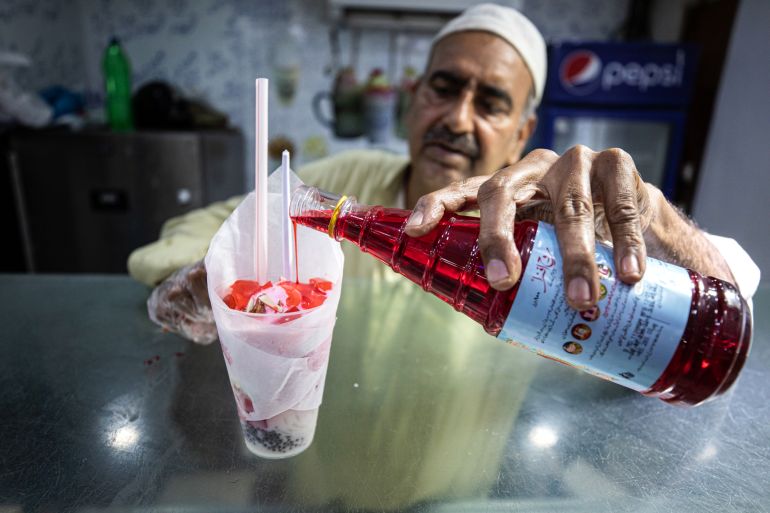
Fork the System is Al Jazeera’s home for all things food. From Syria to Uganda, Bangladesh to Colombia, we look at how food makes us, a forkful at a time, generation after generation.
There is a story told in the lanes of Old Delhi of a building that smells of roses. The building is now abandoned, but if you walk inside you will not see the caved-in roof or the broken walls. You will be distracted by a mehek, a smell, that people who live and work in these lanes say they know well. It lives on, almost as though it has seeped into the very foundations, even after all these years.
Keep reading
list of 4 itemsCinnamon summers: On being Libyan, and British
Heritage, history, and Dhakaiya food in Bangladesh
Rooh Afza off shelves: India’s Muslims have a Ramadan crisis
In 1907, a hakim (herbalist) had his clinic in this building in the Lal Kuan Bazaar. On a sweltering summer’s day, he decided to try to make a cordial for his patients, to refresh and hydrate them and soothe away the ailments the heat brought them. The smell of the cordial wafted out of his clinic – the Hamdard Dawakhana, “Hamdard” being a companion in times of suffering – and through the bazaar. It was intoxicating. Word spread quickly, and a crowd gathered. By nightfall, the hakim’s first batch was finished.
The people in those lanes did not know what was in the sweet, ruby-red concentrate, but those first customers to try the hakim’s creation passed down stories of its taste and smell. It was unmistakable: roses.

Hakim Abdul Majeed named this drink Rooh Afza – the soul refresher. He used distillates of herbs, fruits, flowers and vegetables to make a concentrate that was mixed with water or another liquid and consumed. It is believed to have had up to 21 ingredients known for their cooling properties, including sandalwood, vetiver, purslane, screw pine, mint, spinach, and the heady rose.
He was a practitioner of Unani Tibb – “Yunan” is the Arabic term for Greece, while “Tibb” is medicine, and this system derives its philosophy from Greek physicians but is used to refer to Islamic or Eastern medicine. While Unani Tibb has been formally recognised by the Pakistani government since 1965, this holistic approach to medicine has been studied in the subcontinent since the time of Avicenna.
Hakim Majeed could not have known on that summer day in 1907 that in 40 years, India as he knew it would cease to exist, as the subcontinent was cleaved in two and his own family was split between India and the new country of Pakistan. He could not have guessed that his work would survive the bloodshed of partition. That in the decades to come, Rooh Afza would travel far beyond the lanes of Old Delhi to 37 countries. That in the alchemy of his simple ingredients was the beginnings of a scarlet empire.
‘The King paints the globe red’
In March 2018, the NASDAQ screen in New York’s Time Square lit up with the colours of the Pakistan flag as an advertisement for Rooh Afza played. It was the first time the green and white flag had been displayed in Times Square, part of a campaign launched by Usama Qureshi, the 37-year-old old CEO of what was now Hamdard Laboratories Pakistan.
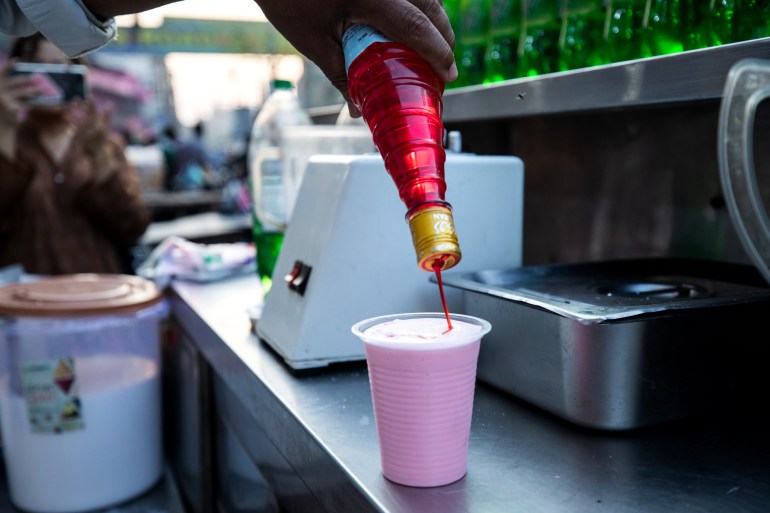
That moment in Times Square was a bold announcement: Hamdard had global aspirations for Rooh Afza. It had long been sold outside the subcontinent in “ethnic” grocery stores to cater to waves of South Asian immigrants as far as Australia. In 1995, a New York Daily News story about ice cream toppings referred to a “thick milk mix-in known as Rooh Afza” that was sold at a Bangladeshi shop on Lexington Avenue for $4 a bottle. It “looks like cherry juice and tastes like perfume”, the reporter noted, and it can be used to make “the national sundae known as faluda” (a cold dessert of vermicelli, rose syrup, basil seeds and milk topped with ice cream).
More than two decades later, hundreds of passers-by in New York were served Rooh Afza as the advertisement on the Nasdaq screen proclaimed: “The King paints the globe red.” Qureshi was no longer satisfied with the status quo. He wanted Rooh Afza on shelves at major supermarkets. It was an ambitious leap forward for a company that had started from scratch in the new state of Pakistan in 1948.
Partition, identity, and tradition
When Hakim Majeed passed away in 1922, his wife Rabia Begum managed his clinic’s work for a few years until her eldest son, Abdul Hameed, took over. She declared Hamdard a waqf, an Islamic charitable trust, wherein all profits would go towards public welfare.
Rabia Begum’s younger son, Mohammed Said, was inspired by the Muslim League, a political party advocating for the separate Muslim state of Pakistan and freedom from British colonial rule. He wanted to become a journalist, but his older brother Abdul Hameed convinced him to study medicine. In 1940, as the Muslim League was passing a resolution demanding independence, Mohammed Said graduated with a degree in eastern medicine. By 1948, while his brother remained at the helm of the company in India, Said migrated to Pakistan, with the plan to set up Hamdard there too. He brought with him his father’s formula for Rooh Afza.
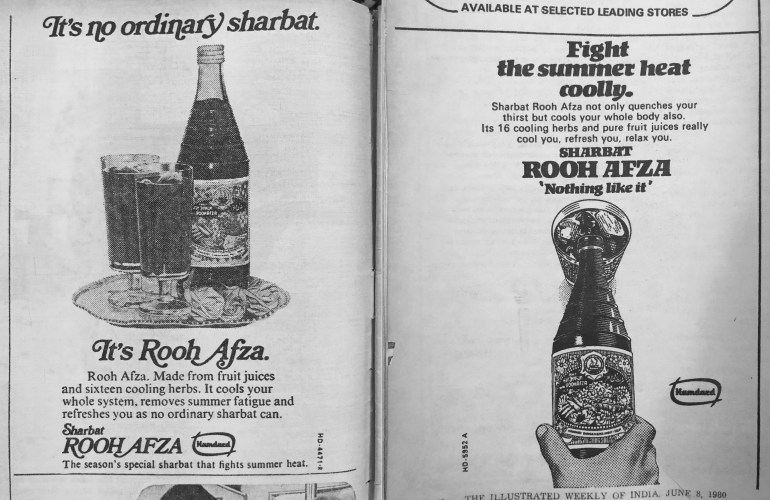
The original recipe has been guarded and remains virtually unchanged, except for small tweaks by Said, explains his daughter Saadia Rashid, now president of Hamdard Pakistan. For instance, as kewra (screw pine) was not available in Pakistan, Hakim Said used the less overpowering gul-e-bahaar (spring rose) instead. The flowers of the turanj (citron) fruit, which grow for only one month or so in the northern areas of Pakistan, were used as distillates too.
At first, Said was making every bottle of the cordial himself at his clinic in Karachi’s Arambagh neighbourhood. On the first day, he sold 12 bottles. Demand steadily grew and by 1953, he opened a manufacturing unit in Nazimabad – a neighbourhood so sparsely populated at the time, Rashid recalls, people joked only mice scurried around there.
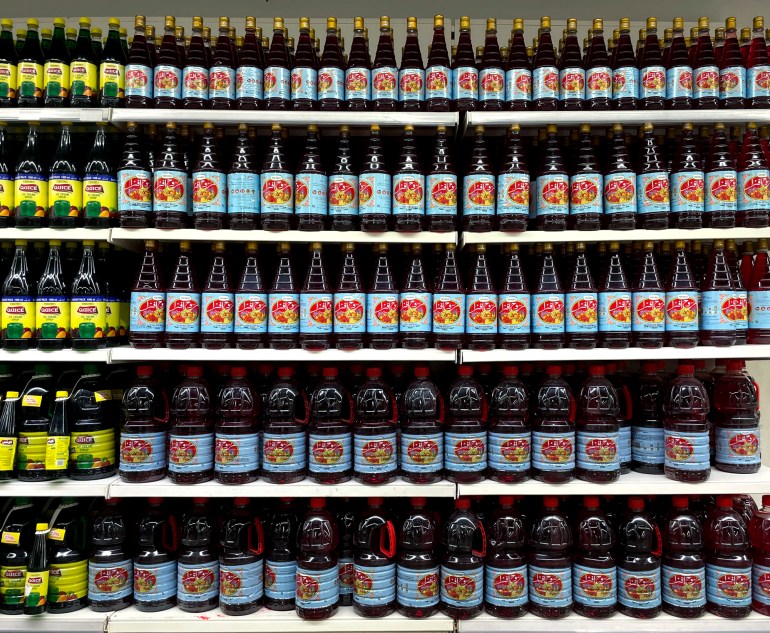
Hakim Said was an astute marketer. He wrote his own advertising copy and dubbed Rooh Afza “mashroob-e-mashriq” – the summer drink of the East. Advertisements in newspapers, magazines and women’s weeklies promised that it would “replenish vigour in the summer’s heat”, slake thirst and cure fatigue.
Bringing Rooh Afza into the home was important, and advertisements featuring hand-drawn illustrations of wedding invitations and musicians encouraged families to welcome their guests with glasses of Rooh Afza to deepen “friendship and feelings of attachment”. In another, a woman cooking in her overheated kitchen pauses to mop her brow while bold advertising copy advised her to refresh herself with a glass of Rooh Afza.

Advertisements and stories about Rooh Afza were placed in children’s magazines, including Hamdard’s own magazine, Naunehal. Well-known children’s stories were rewritten to swap water or milk for Rooh Afza. “That’s how Hakim Said connected with a generation,” Faizullah Jawad, Hamdard’s director of marketing and business development, explains.
“He understood that if you create a habit in them, they’ll carry it for life. Rooh Afza would become their brand.”
On both sides of the border, a generation of children was encouraged to drink milk made more attractive by the lashings of sweet Rooh Afza their mothers swirled into it.
For some who had it only as a rare sweet treat, Rooh Afza was the stuff of dreams. As a child in Kurnool in southeast India, writer Archana Pidathala was allowed Rooh Afza only at birthday parties. When she moved to Bangalore (now known as Bengaluru) as an adult, she was free to indulge, drinking Rooh Afza with basil seeds at juice shops or faluda ribboned with the syrup at a dhaba, a roadside eatery.
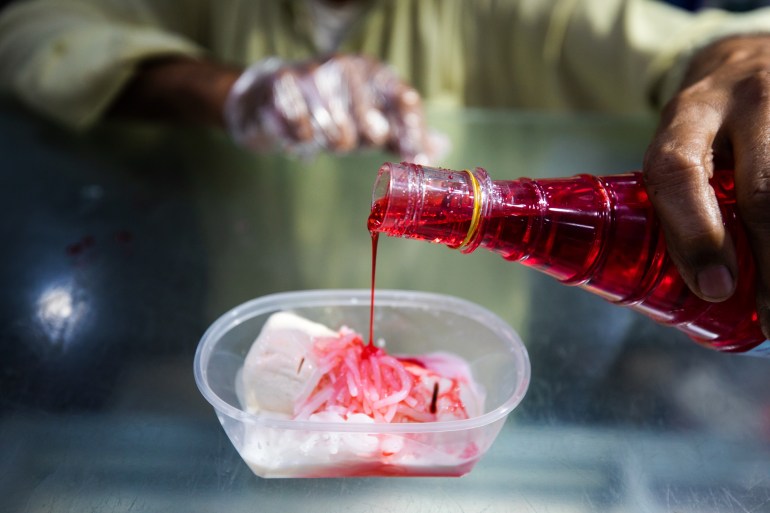
Rooh Afza was positioned as Pakistan’s de facto “national drink”. At a time when it was not the norm, the company sponsored hockey and squash tournaments. “[H]ockey stars like Samiullah Khan were served Rooh Afza during breaks in the game,” says Jawad.
During the India-Pakistan war of 1965, fighter pilots on one mission were bid farewell with miniature copies of the Quran and an imam zamin (an amulet in the form of a cloth band tied to the arm believed to give the wearer protection). On their return, they were received by their commander-in-chief’s wife, who served them chilled milk with Rooh Afza.
Over the decades, even as relations sour between India and Pakistan, traces of a shared past invariably emerge in traditions, and most often, in a shared palette. While in Pakistan, glasses of Rooh Afza are served on iftar and Eid tables, Bombay (now Mumbai)-based music producer Tushar Bhatia, who created the soundtrack for the cult hit Andaz Apna Apna, was commissioned to write a jingle for Rooh Afza by Hamdard India in the early 1990s in time for Diwali. He simply used three words in the whole advertisement, “Hamdard Rooh Afza”, as the drink’s connotations of celebration, refreshment and sweetness were already so well-known, and the words were repeated over a crescendo of dhol, tasha and nagara – different types of percussions and drums.
When the Soviet Union invaded Afghanistan, refugees poured into camps in Peshawar, and bottles of Rooh Afza were sent by Hamdard as part of relief supplies. They were welcomed by the refugees, but Hamdard’s managers were mystified by the number of bottles the camps were going through every day. Upon investigation, it was found that Afghans had their own preferred way of drinking Rooh Afza: they would pop the cap and drink the cordial neat, without diluting it.
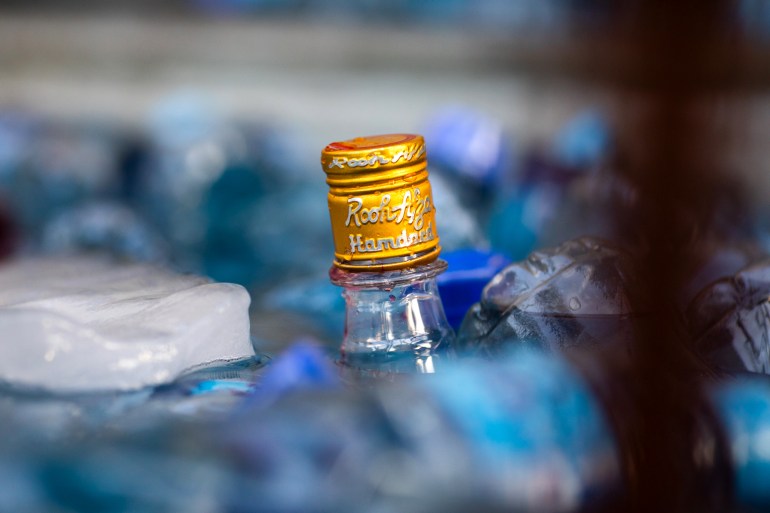
Dr Abdul Hannan, director of Hamdard’s clinical sciences division, migrated from Delhi to Karachi in 1970 to work with Hakim Said. He tells of watching workers at the Rooh Afza plant soaking their rotis, unleavened bread, in the thick syrup and eating them at lunch. “It keeps us in good shape,” they would explain to him.
Across the border in India, a similar belief in Rooh Afza as a cure-all persisted: in some villages in Punjab in the 1980s, there are even stories that it was poured in car engines to cool them down after they overheated.
But above all, for Muslims from the subcontinent, Rooh Afza had an unbreakable connection with Ramadan. After a long day of fasting, the drink quenches the thirst and gives a much-needed hit of sugar. “The adults broke their fast with a date, as is prescribed by the Sunnah, the teachings of Prophet Muhammad, and then they would have a glass of Rooh Afza right after,” Dr Hannan says.
“As a child, I thought both – the date and the Rooh Afza – were Sunnah because no one broke their fast without them.”

Delhi-based writer Rana Safvi recalls that there was no refrigerator in her home in the 1960s, so the family would pour Rooh Afza over slabs of ice from the market in order to have jugs of the cold drink at iftar.
Food writer Dina Begum, born in Sylhet, Bangladesh, says that even after her family migrated to the United Kingdom in 1984, Rooh Afza was always at their iftar table. Bombay native Tasneem Mohamedbhai, who lives in Amsterdam, says the Bohra (a Muslim sect) community send a Ramadan package to every member of the community in the Netherlands and Belgium. In it are supplies like corn flakes, oats, sugar, ghee and milk.
And, always, a bottle of Rooh Afza.
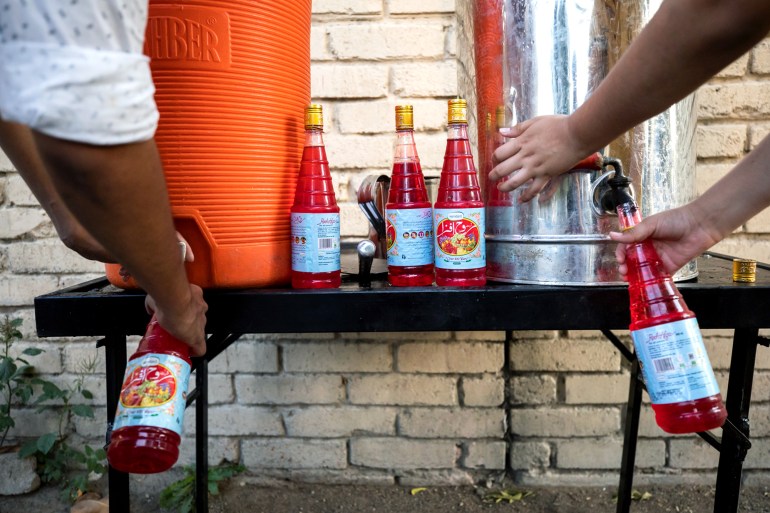
‘The roof from over our heads’
In 1980, Hakim Said’s 34-year-old daughter Sadia Rashid joined the company. Her father, a principled man, was not going to give her any special treatment and she was given a desk opposite his secretary, Mrs D’Silva.
“No task was too menial,” she recalls. “Even if Mrs D’Silva told me to staple papers, I did it.”
As she learned the ropes, Rashid was able to observe her father as he worked seemingly around the clock. “He wouldn’t waste a minute,” she said.
Hakim Said used to say that for two days a week he was an ustaad (teacher), for two days a tabib (one who cures the sick), and for two days a businessman. When he was not training apprentices or treating patients, he was still on the go. Rashid remembers being at an airport with him, waiting, when he pulled out paper and pencil and got to work on a logo for Hamdard.
Thirteen years later, Hakim Said served as governor of Sindh for a year, speaking out against corruption. In 1998, he was shot by members of a rival political party. He was 78.
Rashid took over, inheriting a company that felt her father’s loss keenly. He had been in charge of so much that even the art department had no computerised designs for its labels or packaging – he had overseen it all, working with a painter and calligrapher. “It felt as though we had lost the roof from over our heads,” recalls Dr Hannan.
The company persevered under Rashid’s leadership, continuing to make steady profits, but it never really experimented, not even with the bottles Rooh Afza was sold in. “When I joined Hamdard [in 1999], I remember that all day you would hear the sound of smashing glass at intervals from the factory floor,” says marketing manager Jawad. Making the change from glass bottles to PET that year faced resistance because retailers worried customers would reject the plastic bottles. See, the glass ones were reusable and, as Jawad himself recalls, there is a memory many Pakistanis have of using an emptied Rooh Afza bottle to store and chill water in – the water would be infused with the taste and smell of the syrup.
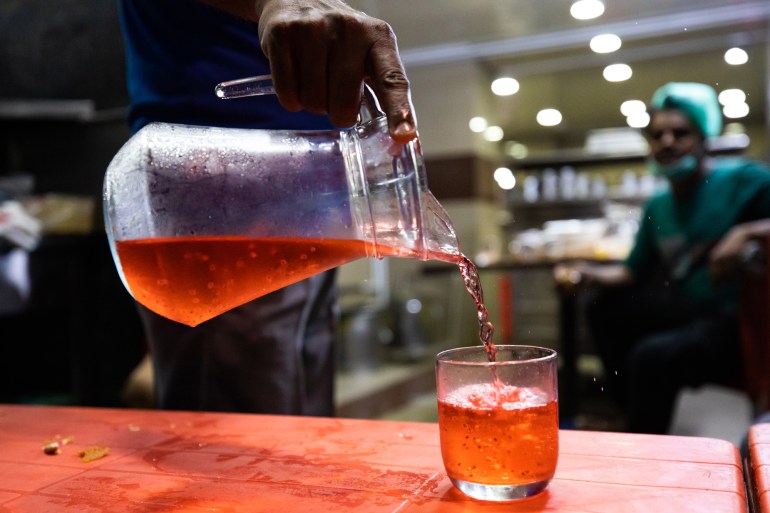
By 2017, Hamdard found itself in danger of falling behind the times as it was now dealing with a new generation of consumers that did not have the nostalgic connection with a brand like Rooh Afza. “If we wanted to survive, we had to come up with new things,” Rashid says.
The first big change was the decision to hire a CEO who was not from the family.
Usama Qureshi had grown up drinking milk with Rooh Afza and reading Hamdard’s children’s magazine, Naunehal. Hakim Said had inaugurated the college he studied at and visited as a guest of honour at special events. When Qureshi joined Hamdard, he was embarking on a labour of love. “I felt like it was a cause, not just a job,” he explains. “I did it for my generation who are parents or becoming parents, so their kids would know Hamdard the way that we did.”
By the time Qureshi joined, the company was making 9 billion rupees ($48m at the current exchange rate) in revenue. It had a roster of 500 products, including gripe water, remedies for constipation, toothpaste, “detoxifying” syrups that promised clear skin, and herbal teas for relieving coughs. Rooh Afza was Hamdard’s star product: by 2017, it was selling 70 to 80 million bottles annually.
In 2019, when a shortage made the news in India, Qureshi tweeted jokingly that Hamdard Pakistan was willing and able to send the beloved drink across the Wagah border. In 2021, Rooh Afza brought in $45m in profit for Hamdard India, according to The New York Times.
Qureshi’s new job was not without its challenges. The public saw Hamdard as an “old and stubborn brand”, he said, and the packaging and marketing were “obsolete”. Most of the people at the company had been there since before he was born.
He did not mince his words. “Organisations that do not change, die.”
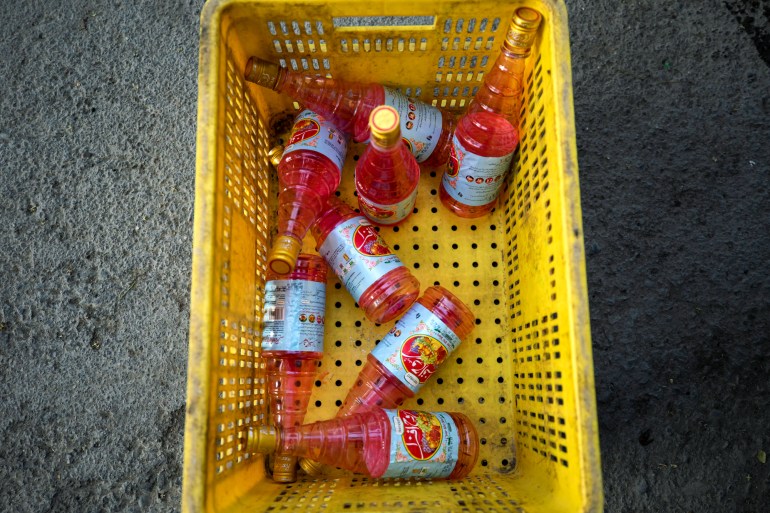
Change or die
When Qureshi decided to shake things up, he was understandably nervous. “Rooh Afza is 70 to 75 percent of Hamdard’s revenue,” he explains. “It’s a big gamble if the change you’re making doesn’t work or alienates consumers.” He engaged a Swiss company of food consultants and kept experimenting with new formats.
“I drank Rooh Afza with sparkling water, and one day, I wondered – what if we created a carbonated version,” he says. And so, Rooh Afza Go, a fizzy drink in a can, was launched in 2019. Qureshi did not expect it to be profitable competing in a carbonated drinks market dominated by global giants at a price point prohibitive to many. “This was something new, something that got affluent consumers curious,” Qureshi explained. He wanted to get a conversation, a viral moment, going.
Hamdard has since promoted the versatility of Rooh Afza, highlighting the fact that it can be added to food, dessert, used as a flavouring, or mixed with any liquid. The company created a combo with Sprite, a milky Doodh Rooh Afza, a sugar-free version and “fusion” flavours in ready-to-drink packaging. It experimented with varieties at food festivals, such as Pom Chiller (with pomegranate), Chill-o-Cran (with cranberries) and Melted Chocolava (dark chocolate and Rooh Afza).
Rooh Afza’s customers have also been creating their own twists. The iterations are beyond anything Hakim Abdul Majeed could have imagined. In Delhi, writer Safvi visited a street vendor near Jama Masjid who mixes it into an icy milk-and-watermelon drink to make sharbat-e-Mohabbat (the drink of love).
Architect and urban designer Uzair Siddiqui in Berkeley, California, grew up drinking Rooh Afza, and now creates his own versions of the cordial. A go-to flavour is steeped hibiscus cooled and added to a mixture of muddled strawberries, Rooh Afza and kumquat zest.
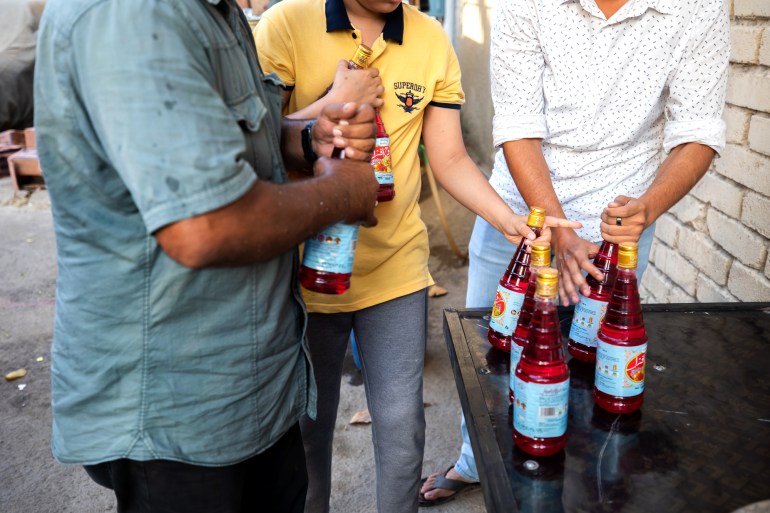
The concentrate is used as a mixer in cocktails, in ladoos (sweets), mousse, the Middle Eastern pudding mahalabia, popsicles, and in souffle.
In Bangladesh, anthropologist Lotte Hoek found, Rooh Afza is prized for its crimson hue and is used on film sets as a substitute for blood; makeup artists add flour to the mixture to make “a sticky viscous version to smear on cut cheeks and grazed arms”.
Under Qureshi, the marketing began to target a younger audience. One of the first new advertisements featured a father writing to his daughter, newly married and moved away. He sends her a bottle of Rooh Afza – a balm for homesickness and a reminder of his love. A social media campaign encouraged people to share photographs and stories about their fathers.
The company met compliance criteria for exports to the West, and began stocking at supermarkets like Tesco in the United Kingdom, Walmart in the United States and Woolworths in Australia. Hamdard’s four factories in Karachi, Lahore and Peshawar churn out up to 600 bottles of Rooh Afza a minute every day. And this year, it expects a 15 percent increase in export.
Dina Begum, the food writer, talks fondly of the drink as a childhood treat that evokes powerful memories of belonging, particularly for those in the diaspora community. She has noticed a resurgence in Rooh Afza’s popularity outside South Asia in recent years, fuelled in part by the mainstreaming of foods like ghee or yakhni (bone broth) in the West. It does not hurt that the syrup is aesthetically pleasing. “It’s Instagrammable!” she says.
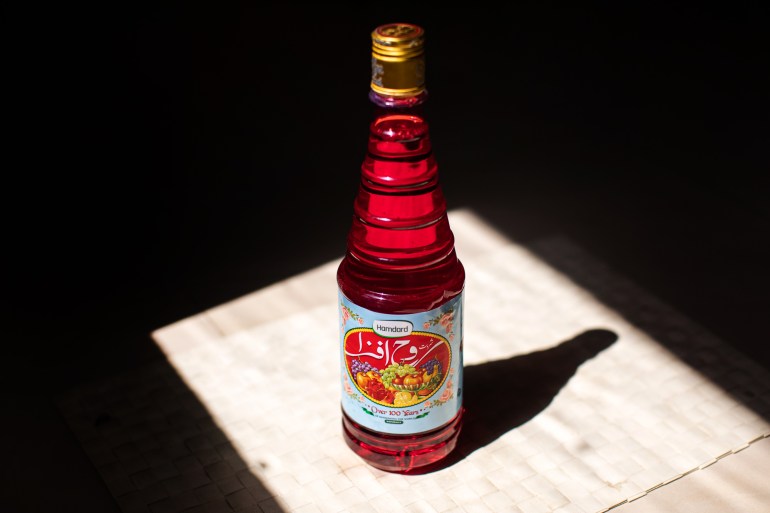
As the West embraces South Asian flavours such as haldi-doodh (turmeric milk), Begum wonders if Rooh Afza is waiting for its moment. “If we can get turmeric lattes at Starbucks, perhaps a Rooh Afza latte is not far behind.”
Yes, Hamdard’s revamped social media strategy, diversification or marketing could be responsible for Rooh Afza’s endurance, says Dr Hannan, but he has another theory.
“You want to know the business secret? Hamdard does two kinds of business: it sells to the public, and it does business with Allah,” he says. As an Islamic trust, profits are channelled into education, healthcare and charity.
“As Muslims, we believe that if we do business with Allah, He will multiply what we earn. It is Allah’s help that we receive. And what can beat that?”